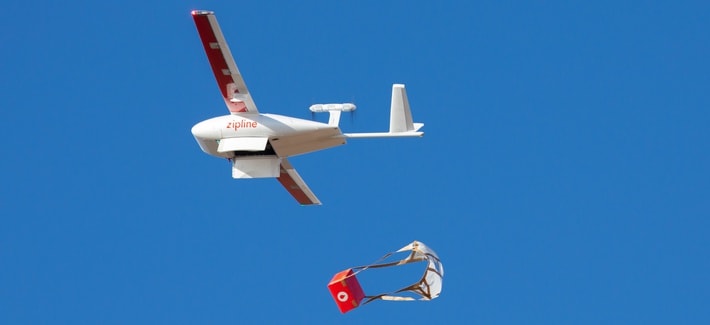Blood Delivery Drones Look To Save Lives
There’s been a lot of talk of using drones for delivery, but usually in the context of residential or commercial deliveries. Zipline, a drone delivery company, is looking to add on to that with medical supplies and blood. Blood deliveries are important, and can be life saving, and zipline is looking to bring that life saving goodness to places that might otherwise not be able to get it. Through the use of drones, they’re looking to make deliveries in remote locations, disaster stricken areas, and even hostile environments like war zones.

Recently, Zipline, the U.S Marines air ground task force, and austrailian defense forces did a series of tests involving the drones. During the operation, they did over 380 deliveries of blood and other medical supplies. With a top speed of over 79 miles, these little drones put in some serious work to save lives. With a range of up to 100 miles, they can cover some serious area too, and have the speed to reach even their furthest reaches relatively quickly.
The exercise itself was a joint operation between the military and civilian contractors. It looks to explore options for using drones in delivery, in particular to conflict areas that are dangerous and difficult to get to. By leveraging drone technology, life might be saved in the fast paced combat zones where every second counts.
The drones themselves follow a GPS flight path, and can be reassigned mid flight by radio from transmitter stations. Interesting enough, ziplines drone’s are all styrofoam skins, which means that the 11 foot wingspan drone only weighs 25 pounds. All the drones are networked together, which helps them avoid mid-air collisions. The technology behind the setup has taken some serious work by Zipline to perfect, but it looks to have paid off with much success reported by the company.
While the operation was a test, zipline has been active in this area since 2016 delivering medical supplies in Rwanda. Rwanda is known for seasonal rains, which can make deliveries via roads impossible, but not for drones. Zipline’s drone have been tested against gale force winds, so a little rain is no problem for them. While they do many routine deliveries, roughly a third have been emergency deliveries. They were able to bring blood to hospitals that had run out and desperately need more.
They’ve also deployed a series of 30 drones in Ghana for similar deliveries. Here they utilize a series of stations to help drones cover longer distances than possible in a single trip. They’re also currently in the process of setting up in India and even in the United States where we saw them delivering to specific medical locations in North Carolina.
While the military applications are easy to see, Zipline also has plans to help with things like disaster relief. After hurricanes for example, roads might be flooded or damage to the point where supply vehicles can’t use them. Drones have no such limitation though, and would easily be able to circumvent obstacles to deliver life saving supplies.
While the technology is very promising, Zipline admits that they aren’t quite ready for rapid response work yet. Their Australian exercises had a week leading up to it used to establish the drone base. This is certainly not going to cut it for quick response, but they recognize this and are working to reduce the time it takes to get off the ground.
There still remains a lot of work to do, but the technology and companies behind disaster relief drones are very promising. With the right efforts, this is technology that will certainly save lives, and that’s something worth working towards.






Zip line does awesome work.
Rick Adams, SFC, ret.